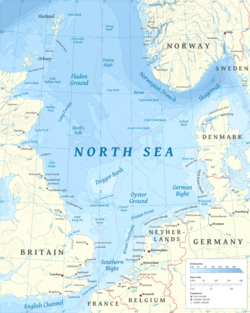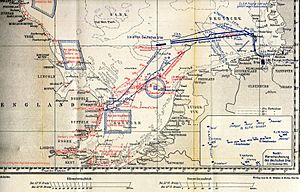Raid on Yarmouth facts for kids
Quick facts for kids Raid on Yarmouth |
|||||||
|---|---|---|---|---|---|---|---|
| Part of the First World War | |||||||
 North Sea |
|||||||
|
|||||||
| Belligerents | |||||||
| Commanders and leaders | |||||||
| Strength | |||||||
| 3 destroyers 1 minesweeper 3 submarines |
3 battlecruisers 1 armoured cruiser 4 light cruisers |
||||||
| Casualties and losses | |||||||
| 21 killed 3 wounded 1 submarine sunk |
235 killed 1 armoured cruiser sunk |
||||||
| Three British fishing trawlers were sunk during the raid | |||||||
The Raid on Yarmouth happened on November 3, 1914. It was an attack by the Imperial German Navy on the British town of Great Yarmouth. This town is a port on the North Sea coast of England. German ships fired shells that mostly landed on the beach. They caused very little damage to the town itself. This happened because British destroyers interrupted the German ships as they were laying mines in the water. A British submarine, HMS D5, sank after hitting a German mine. This occurred as it was leaving the harbour to attack the German ships. Later, a German armoured cruiser also sank. It hit two German mines outside its own home port.
Contents
Why Did Germany Attack Yarmouth?
In October 1914, the German Navy wanted to reduce the number of ships the Royal Navy had. The British Navy was much larger. A big battle between the whole fleets was too risky for Germany. German leaders decided to attack British ships one by one or in small groups. This would slowly make the British fleet smaller.
The German Emperor, Kaiser Wilhelm II, said that no large fleet battles should happen. But small groups of ships could still go on raids. These German raids had a few goals. They wanted to lay mines in British waters. They also hoped to sink single British ships. Another goal was to trick larger groups of British ships into chasing them. If the British chased, they might be ambushed by the main German fleet. This would happen in safer waters closer to Germany.
Attacking British towns on the coast might also make the Royal Navy change its plans. The British usually kept most of their ships, called the Grand Fleet, together. This made sure they were strong if they met the German Navy. Germany hoped these raids would make Britain send more ships away from the Grand Fleet. These ships would then protect the coast. This would make it easier for the German Navy to attack isolated British ships. The Grand Fleet would be too far away to help.
Getting Ready for the Raid
The Yarmouth raid was carried out by a group of German ships. This group was led by Admiral Franz von Hipper. It included three large ships called battlecruisers: SMS Seydlitz, Von der Tann, and Moltke. There was also a slightly smaller armoured cruiser, Blücher. Four light cruisers joined them: SMS Strassburg, Graudenz, Kolberg, and Stralsund.
The plan was for these ships to lay mines near Yarmouth and another town called Lowestoft. After that, they would use their big guns to bombard Yarmouth.
The Attack on Yarmouth
At 4:30 PM on November 2, 1914, the German battlecruiser group left its base. This base was on the Jade River. Two groups of German battleships followed them a bit later. These battleships were waiting to ambush any British ships that the battlecruisers might lure out. By midnight, the German ships were far enough north. They passed fishing boats from different countries.
By 6:30 AM on November 3, the German patrol saw a special marker buoy. This buoy was at a place called "Smith's Knoll Watch." It helped them know their exact location. They then moved closer to Yarmouth. The coast near Yarmouth was being patrolled by a minesweeper ship, HMS Halcyon. Two old destroyers, HMS Lively and Leopard, were also on patrol.
Halcyon saw two German cruisers. It challenged them, asking who they were. The German ships answered by firing shells. First, they used smaller guns, then larger ones. One person who was there wrote that shells were falling all around. The ship was getting soaked with water. One sailor was killed by a piece of a shell.
The destroyer Lively was about 2 miles (3.7 km) behind Halcyon. It started making smoke to hide the British ships. The German shooting was not very accurate. This was because all the battlecruisers fired at Lively at the same time. This made it hard for each German ship to see where their shells landed and correct their aim.
At 7:40 AM, Admiral Hipper stopped firing at Lively. He then aimed some shells toward Yarmouth itself. These shells hit the beach. Once the German ship Stralsund finished laying its mines, the German ships left.
Halcyon was now out of immediate danger. It sent a radio message warning that German ships were in the area. The destroyer HMS Success moved to join the other British ships. Three more destroyers in the harbour started getting ready to sail. Three submarines, HMS E10, D5, and D3, were inside the harbour. They moved out to chase the German ships. But D5 hit a mine and sank. At 8:30 AM, Halcyon returned to the harbour. It gave a report of what had happened.
At 9:55 AM, Admiral David Beatty was ordered to sail south with his battlecruiser group. Other groups of the Grand Fleet followed from Ireland. By this time, Admiral Hipper was already 50 miles (93 km) away. He was heading back home. German ships waited overnight in a place called Schillig Roads. They were waiting for fog to clear before returning to their harbour. In the fog, the armoured cruiser SMS Yorck went off course. It was traveling from the Jade Bay to Wilhelmshaven. It hit two mines. Some of the crew survived by sitting on the wreck of the ship. It had sunk in shallow water. But at least 235 men were killed.
What Happened Next?
Admiral Hipper received an Iron Cross medal. But he refused to wear it. He felt that his raid had not achieved much. Even though the results were not amazing, German commanders were happy. They saw how easily Hipper had arrived and left. This made them want to try another raid.
The British did not react strongly to the raid. This was partly because they had just heard bad news that morning. A much more serious loss had happened at the Battle of Coronel. Also, Admiral John Jellicoe, who commanded the Grand Fleet, was on a train. He was returning to his ships when the raid happened.
According to Winston Churchill, a British leader, the British could not believe the raid was just a short shelling of Yarmouth. They were waiting for something bigger to happen.
Ships Involved in the Raid
Royal Navy (British)
- HMS Halcyon, a minesweeper, which was the lead ship
- HMS Lively, a destroyer
- HMS Leopard, a destroyer
- HMS Success, a destroyer
- HMS E10, a submarine
- HMS D5, a submarine
- HMS D3, a submarine
Imperial German Navy
- SMS Seydlitz, a battlecruiser, which was the lead ship
- SMS Von der Tann, a battlecruiser
- SMS Moltke, a battlecruiser
- SMS Blücher, an armoured cruiser
- SMS Strassburg, a light cruiser
- SMS Graudenz, a light cruiser
- SMS Kolberg, a light cruiser
- SMS Stralsund, a light cruiser
See also



